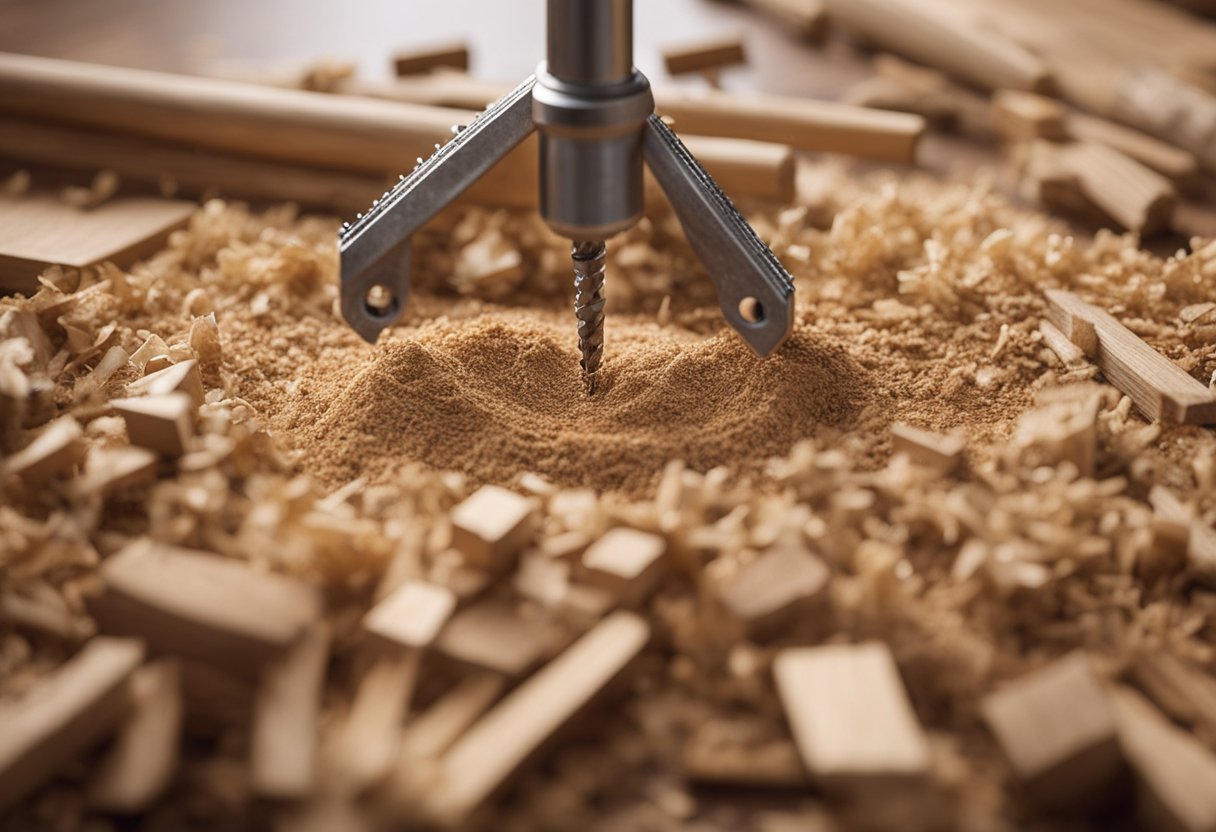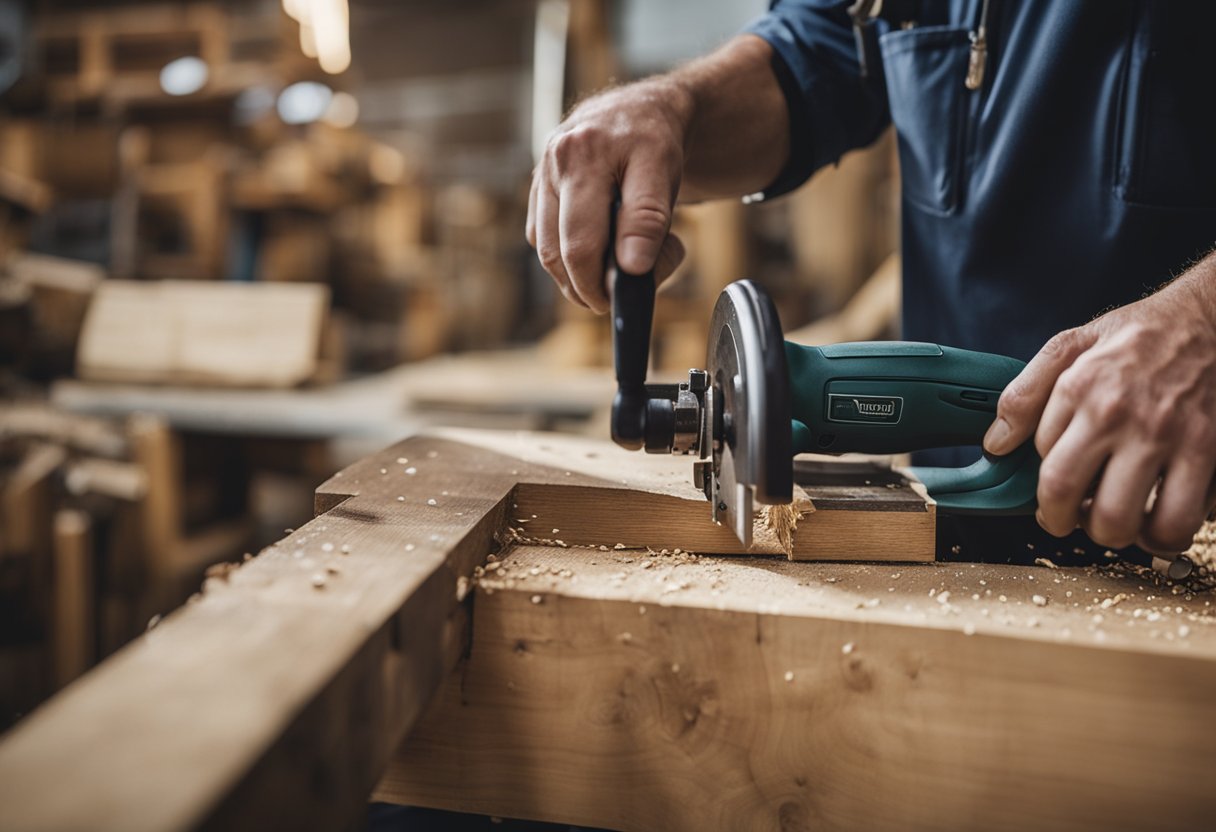Cutting a hole in wood is a common task for many DIY enthusiasts, woodworkers, and carpenters. Whether you want to install a doorknob, make a birdhouse, or create a decorative piece, cutting a hole in wood is an essential skill to master. However, one of the most common problems that people face when cutting a hole in wood is going all the way through. This can ruin the piece and cause frustration, especially if you have spent hours working on it.
Understanding the basics of cutting a hole in wood is crucial to avoid going all the way through. You need to choose the right tools, prepare the wood before cutting, and use the right cutting techniques to ensure precision and avoid damage. Additionally, you need to take safety measures to protect yourself from injuries and use finishing touches to enhance the appearance of the hole. In this article, I will provide you with a step-by-step guide on how to cut a hole in wood without going all the way through.
Key Takeaways
- Choosing the right tools and preparing the wood before cutting are essential to avoid going all the way through.
- Using the right cutting techniques and ensuring precision can help you achieve the desired results.
- Taking safety measures and using finishing touches can enhance the appearance of the hole and protect yourself from injuries.
Understanding the Basics
https://www.youtube.com/watch?v=1hkIPc3SOns&embed=true
Cutting a hole in wood without going all the way through requires precision and patience. It is important to have a clear understanding of the basics before attempting this task. Here are some important things to keep in mind:
Choose the Right Tools
Selecting the right tools is crucial when cutting a hole in wood. You will need a drill, a drill bit, a chisel, and a hammer. It is important to choose the right size of drill bit that matches the size of the hole you want to create. A Forstner bit is recommended for larger holes as they are more precise.
Mark the Spot
Before you start drilling, it is important to mark the spot where you want to cut the hole. Use a pencil to draw a circle around the spot. This will help guide you as you drill and prevent you from going too far.
Drill the Hole
Once you have marked the spot, it’s time to drill the hole. Start by drilling a small hole in the center of the circle. This will serve as a guide for the larger drill bit. Slowly drill the hole, making sure to stop before you reach the other side. You can use a piece of tape on the drill bit to mark the depth you want to reach.
Chisel the Hole
After drilling the hole, you will need to chisel out the wood to create the hole. Use a chisel to carefully remove the wood, making sure not to go too far. It is important to go slowly and use light pressure to avoid damaging the wood. Use a hammer to tap the chisel gently if necessary.
By following these basic steps, you can cut a hole in wood without going all the way through. Remember to take your time and be patient, as precision is key in woodworking.
Choosing the Right Tools
https://www.youtube.com/watch?v=uII0G89fONs&embed=true
When it comes to cutting a hole in wood without going all the way through, choosing the right tools is crucial. The tools you use will depend on the size and shape of the hole you need to create, as well as the type of wood you are working with. Here are some of the most common tools you can use:
Drill Bit
Using a drill bit is one of the easiest ways to cut a hole in wood without going all the way through. Simply clamp the wood in place, choose the right size drill bit, and drill into the wood until you reach the desired depth. Be sure to use a drill bit that is slightly smaller than the size of the hole you want to create to avoid going all the way through.
Chisel
Another option for cutting a hole in wood without going all the way through is using a chisel. This method requires a bit more skill and patience, but it can be very effective. Use a sharp chisel to carefully carve out the wood, making sure to stop before you reach the other side.
Jig Saw
If you need to cut a larger hole or a more complex shape, a jig saw may be the best tool for the job. A jig saw allows you to make precise cuts with ease, and can be used to create holes of various shapes and sizes. Be sure to use the right blade for the type of wood you are working with, and clamp the wood in place to prevent it from moving while you cut.
Router
If you need to create a hole with a specific shape or pattern, a router may be the best tool for the job. A router allows you to make precise cuts with ease, and can be used to create intricate designs and shapes. Be sure to use the right bit for the job, and clamp the wood in place to prevent it from moving while you cut.
Hand Saw
If you don’t have access to power tools, a hand saw can also be used to cut a hole in wood without going all the way through. This method requires a bit more elbow grease, but can be very effective. Use a sharp hand saw to carefully cut out the wood, making sure to stop before you reach the other side.
No matter which tool you choose, be sure to take your time and work carefully to avoid going all the way through the wood. With the right tools and a bit of patience, you can create a perfectly sized hole in your wood project without any mishaps.
Preparation Before Cutting
Before cutting a hole in wood, it’s essential to prepare the wood and the tools you’ll be using. Here are some steps I take to ensure a successful outcome:
1. Choose the Right Wood
Selecting the right wood is crucial when cutting a hole. Plywood is an excellent choice for beginners because it’s easy to work with and doesn’t splinter as much as other woods. If you’re working with a harder wood, like metal, it’s important to use the right tools to avoid damaging the material.
2. Mark the Area to Cut
Using a pencil or chalk, mark the area where you want to cut the hole. This helps you keep track of where you need to cut and ensures that you don’t accidentally cut too deep. You can also use a laser ruler to ensure that your measurements are precise.
3. Secure the Wood
To keep the wood from moving around while you cut, use clamps to hold it in place. This will help you make a more accurate cut and prevent the wood from shifting while you work.
4. Protect the Wood
To prevent the wood from splintering or cracking while you cut, use tape to cover the area around the hole. This will help keep the wood smooth and protect it from damage.
5. Use the Right Tool
Choosing the right tool is essential when cutting a hole in wood. For shallow holes, a router or drill press equipped with a Forstner bit is ideal. For deeper holes, a saw or jigsaw may be necessary. Make sure to choose the right tool for the job to ensure a clean cut.
By following these steps, you’ll be well-prepared to cut a hole in wood without going all the way through.
Cutting Techniques
https://www.youtube.com/watch?v=EEfjUVn7EUc&embed=true
When cutting a hole in wood without going all the way through, there are several techniques that can be used. The most common tools used for this task are a drill press, hole saw, jigsaw, hand drill, and handheld router.
Drill Press
A drill press is a great tool for cutting a hole in wood without going all the way through. It is easy to use and provides a lot of control over the cutting process. Simply set the depth of the drill bit and use the press to drill the hole. This technique works well for circular holes.
Hole Saw
A hole saw is another tool that can be used to cut a hole in wood without going all the way through. This tool is designed to create circular holes and comes in a variety of sizes. It is important to use the correct size hole saw for the job to ensure a clean cut.
Jigsaw
A jigsaw is a handheld tool that can be used to cut a hole in wood without a drill press. It works well for cutting irregular shapes and can be used to make square holes as well. When using a jigsaw, it is important to take your time and follow the line closely to ensure a clean cut.
Handheld Router
A handheld router is another tool that can be used to cut a hole in wood without going all the way through. This tool is designed to hollow out material and can be used to create circular holes as well as irregular shapes. It is important to use the correct bit for the job to ensure a clean cut.
Overall, there are many techniques that can be used to cut a hole in wood without going all the way through. Whether you are using a drill press, hole saw, jigsaw, or handheld router, it is important to take your time and follow the line closely to ensure a clean cut.
Ensuring Precision and Avoiding Damage
https://www.youtube.com/watch?v=TwAOfYY9nKw&embed=true
When cutting a hole in wood, precision is key to ensuring a clean and professional-looking result. However, it’s also important to avoid damaging the wood or causing splintering. Here are some tips and techniques to help you achieve both:
Use a Brace and Bit
One of the most precise ways to cut a hole in wood is by using a brace and bit. This traditional hand tool allows you to drill a hole at a slow and controlled pace, which reduces the risk of slipping or going too far. Plus, you can easily adjust the size of the hole by changing the bit.
Create a Template
If you need to cut multiple holes of the same size and shape, consider creating a template. This can be made from a piece of scrap wood or cardboard, and should be the exact size and shape of the hole you want to cut. Place the template on your workpiece and use it as a guide for your saw or drill. This will help ensure consistency and accuracy across all your holes.
Use a Drill Stop
A drill stop is a small collar that fits onto your drill bit and prevents it from going too far into the wood. This is especially useful if you’re using a power drill, which can easily slip or go too deep. Simply adjust the collar to the desired depth and drill away.
Clamp Your Workpiece
To prevent your workpiece from slipping or moving during the cutting process, be sure to clamp it securely to your work surface. This will also help reduce the risk of splintering or damage to the wood.
Practice on Scrap Wood
If you’re new to cutting holes in wood, it’s a good idea to practice on a piece of scrap wood first. This will give you a chance to test out different techniques and tools without risking damage to your final project.
With these tips and techniques, you can ensure precision and avoid damage when cutting holes in wood. By taking your time and using the right tools, you can achieve professional-looking results every time.
Finishing Touches
Now that you have successfully cut a hole in your wood without going all the way through, it’s time to add some finishing touches. The first step is to sand the edges of the hole to make them smooth. Use a fine grit sandpaper to avoid scratching the surface of the wood.
If your hole has any burrs or rough edges, you can use a deburring tool to remove them. A deburring tool is a handheld device that is designed to smooth out rough edges and remove burrs. Simply run the tool along the edges of the hole until they are smooth.
Once you have sanded and deburred the hole, you can apply a finish to the wood. A finish will protect the wood from moisture and give it a polished look. There are many different types of finishes available, including varnish, lacquer, and wax. Choose the finish that best suits your project and apply it according to the manufacturer’s instructions.
Remember, taking the time to add these finishing touches will make your project look more professional and polished. It’s worth the extra effort to ensure that your work is of the highest quality.
Safety Measures
When cutting a hole in wood without going all the way through, safety should be a top priority. Here are some safety measures to consider:
-
Wear Safety Gear: It is important to wear safety gear such as safety goggles, gloves, and earplugs to protect yourself from flying debris, dust, and loud noises.
-
Secure Wood: Ensure that the wood is securely clamped or held down to prevent slipping or moving during the cutting process. This will also help to prevent the wood from splitting or cracking.
-
Use Proper Tools: Use the appropriate tools for the job. For example, a drill press equipped with a Forstner bit or a router is best for cutting shallow holes. A hole saw can also be used but requires more caution to avoid going all the way through the wood.
-
Handle Tools with Care: Always handle tools with care and ensure that they are in good condition before using them. Do not force the tool through the wood, let it do the work.
-
Avoid Slip-ups: When using a drill or other power tools, avoid putting too much pressure on the tool or the wood. This can cause the tool to slip and damage the wood or injure yourself.
By following these safety measures, you can ensure that your woodworking project is completed safely and successfully.
Additional Resources
https://www.youtube.com/watch?v=BL-Xa8-xK44&embed=true
If you want to learn more about cutting holes in wood without going all the way through, there are many resources available to you. Here are a few that I recommend:
-
Joinery Techniques: Learning about different joint techniques can help you create stronger connections between pieces of wood without having to cut all the way through. Some common joint techniques include dovetail joints, mortise and tenon joints, and biscuit joints. These techniques can be used to create holes that don’t go all the way through, and they can also add decorative elements to your woodworking projects.
-
Forstner Bits: Forstner bits are a type of drill bit that can be used to create clean, precise holes in wood. They are often used for woodworking projects because they can create flat-bottomed holes that are perfect for adding inlays or other decorative elements. To use a Forstner bit, you will need to create a pilot hole first, and then use the Forstner bit to create the final hole.
-
Circles Cutting Techniques: If you need to cut circular holes in wood without going all the way through, there are a few techniques you can use. One option is to use a hole saw, which is a type of saw that can be used to cut holes of various sizes. Another option is to use a router with a circle cutting jig, which can be used to create precise circular holes in wood.
-
Video Tutorials: If you prefer to learn by watching someone else do it, there are many video tutorials available online that can help you learn how to cut holes in wood without going all the way through. YouTube is a great resource for finding these types of tutorials, and you can also find them on woodworking websites and forums.
-
Pilot Holes: Creating a pilot hole before you start cutting can help you ensure that you don’t cut all the way through the wood. A pilot hole is a small hole that you drill into the wood before you start cutting the final hole. This can help you create a guide for your saw or drill bit, which can help you make more precise cuts.
By using these additional resources, you can expand your knowledge of cutting holes in wood without going all the way through, and improve your woodworking skills.
Frequently Asked Questions
How can I cut a hole in wood without going all the way through?
Cutting a hole in wood without going all the way through can be achieved by using a drill bit with a stop collar. The stop collar is placed on the drill bit at the desired depth, and it prevents the bit from drilling beyond that point. You can also use a handsaw or a chisel to carefully remove the wood in layers until you reach the desired depth.
How do I cut a square hole in wood without a jigsaw?
Cutting a square hole in wood without a jigsaw can be done by using a handsaw or a chisel. A handsaw is used to make the initial cuts, and a chisel is used to remove the wood in between the cuts. Alternatively, you can use a router with a straight bit to make the cuts and then use a chisel to remove the remaining wood.
What are some ways to make a hole in wood without a drill?
There are several ways to make a hole in wood without a drill. You can use a hammer and nail to punch a small hole, then enlarge it with a screwdriver or chisel. You can also use a hole saw attachment on a hand drill, a coping saw, or a keyhole saw. Another option is to use a spade bit and a hammer to chisel out the wood.
What is the best way to cut a large hole in wood?
The best way to cut a large hole in wood is to use a hole saw attachment on a drill. A hole saw is a circular saw blade with teeth that is designed to cut through wood. It is available in various sizes, so you can choose the right size for your project. To prevent the saw from overheating, use a lubricant such as oil or water.
How can I make a recessed hole in wood?
To make a recessed hole in wood, use a Forstner bit on a drill. A Forstner bit is a type of drill bit that is designed to make flat-bottomed holes. Drill the hole to the desired depth, then use a chisel to remove the remaining wood around the edges of the hole.
How do I cut a shallow circle in wood?
To cut a shallow circle in wood, use a compass to draw the circle on the wood. Then, use a jigsaw or a coping saw to carefully cut along the line. If you don’t have a jigsaw or coping saw, you can use a hole saw attachment on a drill to make the cut.

Hi, I’m Sal Muller of Tooltrip.com. My DIY experience led me to understand essential power tools for home projects. Tooltrip.com guides enthusiasts and professionals in choosing right tools for any job. I provide concise top tool reviews for easier, efficient DIY.






